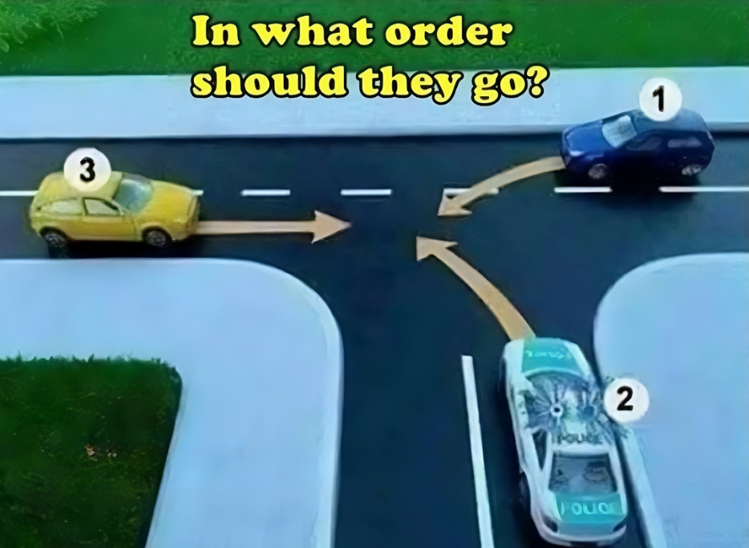A police car (Vehicle 2) and two civilian cars (Vehicles 1 and 3) arrive at a three-way intersection, each coming from different directions. So, who goes first? This scenario sparks many opinions, so let’s explore the possible solutions based on traffic rules, vehicle priority, and common driving situations.
Understanding Right-of-Way Rules

Before we dive into this specific situation, let’s revisit some general road rules for intersections:
- Priority Vehicles: Emergency vehicles like police cars, ambulances, and fire trucks usually get the right of way, especially if their lights or sirens are on.
- Going Straight vs. Turning: Cars traveling straight often have the right of way over those making turns. Vehicles turning left must yield to those coming straight from the opposite direction or to vehicles turning right.
- First to Enter the Intersection: When multiple vehicles arrive at an intersection simultaneously, the car that entered the intersection first typically has the right to go first.
- Uncontrolled Intersections: At intersections without traffic lights or stop signs, the car on the right usually has the right of way, especially if both vehicles arrive simultaneously.
Now that we’ve refreshed these essential rules, let’s break down our specific situation.
Scenario Breakdown
The image shows a police car (Vehicle 2), a yellow car (Vehicle 3), and a blue car (Vehicle 1), each facing different directions. We know the police car is on duty, but should it go first? What about the cars going straight versus those making turns? Let’s analyze based on different perspectives.
The Police Car’s Priority: Honking or Not?
One factor to consider is whether the police car is honking or using its sirens, which signals it is on duty. When emergency vehicles are on duty, they usually have the right of way in almost every situation.
- If the police car is honking or using its sirens: It immediately takes precedence over the other vehicles. In this case, vehicle number 2 would go first, followed by the civilian vehicles.
- If the police car is not honking: The police car must follow regular traffic rules just like any other vehicle. In this scenario, it has no special priority, and the normal rules of right-of-way apply.
Principle of Straight Roads vs. Turns
In most traffic situations, vehicles going straight have the right of way over those making turns. This principle resolves many intersection disputes, and it applies here as well.
- Car 3, which is going straight, has the priority over the cars making turns (Car 1 and the police car, Car 2). This is a fundamental traffic rule that favors vehicles proceeding straight.
- Car 1 is making a left turn and would typically need to yield to cars going straight (Car 3) or those making a right turn (Car 2).
Interpreting the Intersection
We can view this intersection as either a standard three-way intersection or an uncontrolled intersection where no one has special rights. Based on this assumption:
- If we treat it as a level intersection without stop signs or signals, all cars have equal rights at the intersection, so we must apply the right-of-way principles discussed earlier. This would give Car 3 priority as it is traveling straight.
- If the police car is on duty and honking, Car 2 would go first due to its emergency vehicle status.
Possible Solutions Based on Different Situations

Now, let’s detail the possible outcomes based on different scenarios:
- Scenario 1: Police Car Honking (on Duty)
- In this case, Car 2 goes first because it is the priority vehicle.
- Next, Car 3 proceeds, as it is going straight.
- Finally, Car 1 goes last because it is making a left turn.
- Scenario 2: Police Car Not Honking (Following Regular Traffic Rules)
- Car 3 proceeds first since it is going straight.
- Car 1 follows because it’s next in line, even though it’s turning left.
- Car 2 (the police car) goes last, following regular traffic laws.
Which Is the Correct Answer?
If we follow regular traffic rules strictly, the correct answer would likely be 3 – 1 – 2, since Car 3 is going straight and should have the right of way over the others. If the police car is actively using its lights or sirens, the correct order changes to 2 – 3 – 1, with the police car taking priority.
The order in which the cars should proceed depends on the specific situation. If the police car is honking and signaling that it’s on duty, it clearly takes precedence. However, without such signals, normal traffic laws apply, giving priority to the vehicle going straight.
This scenario highlights the importance of context and a solid understanding of traffic rules when navigating complex intersections. Whether you’re driving an emergency vehicle or a civilian car, knowing how to handle these situations can make the roads safer and keep traffic flowing smoothly.